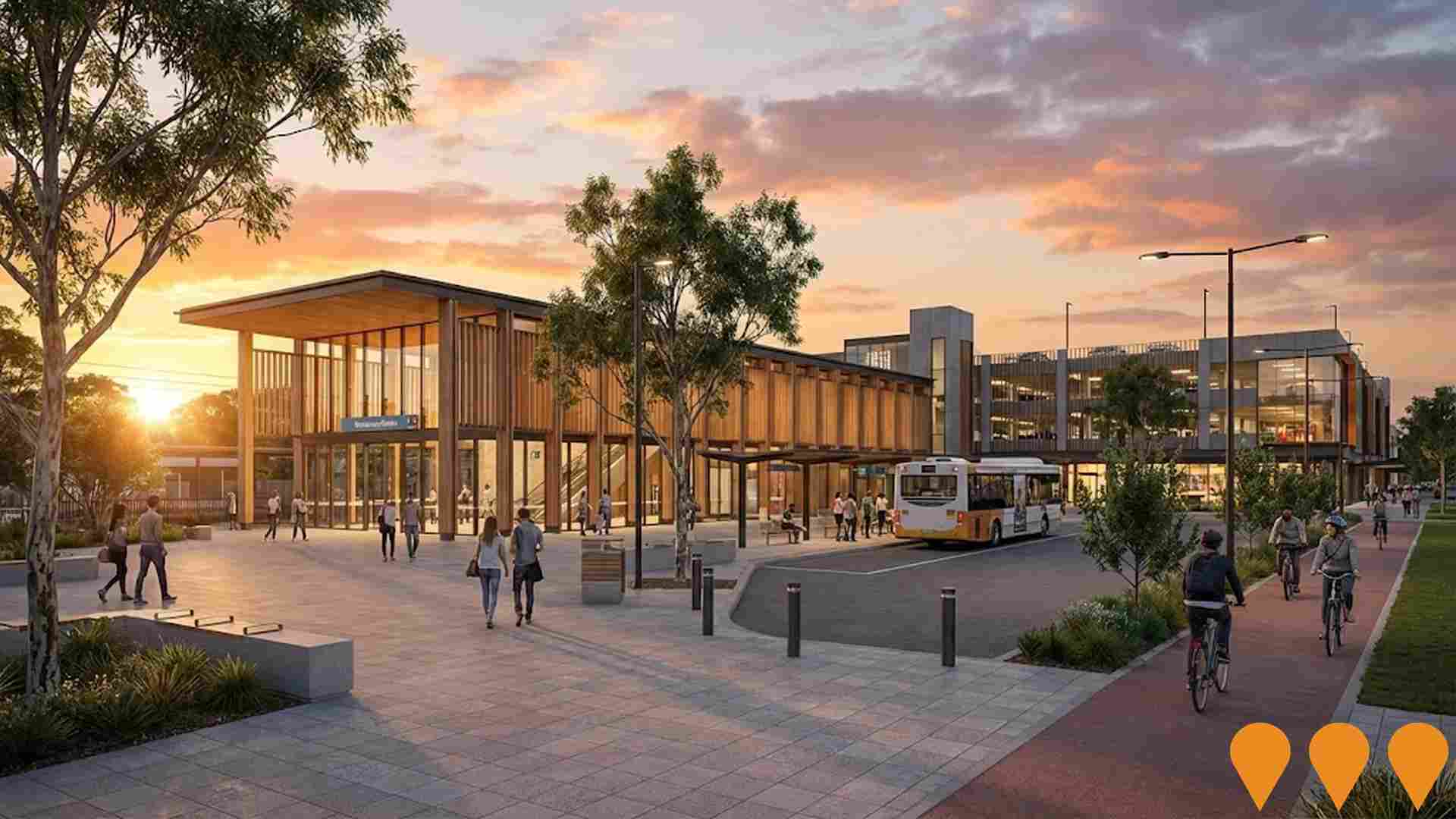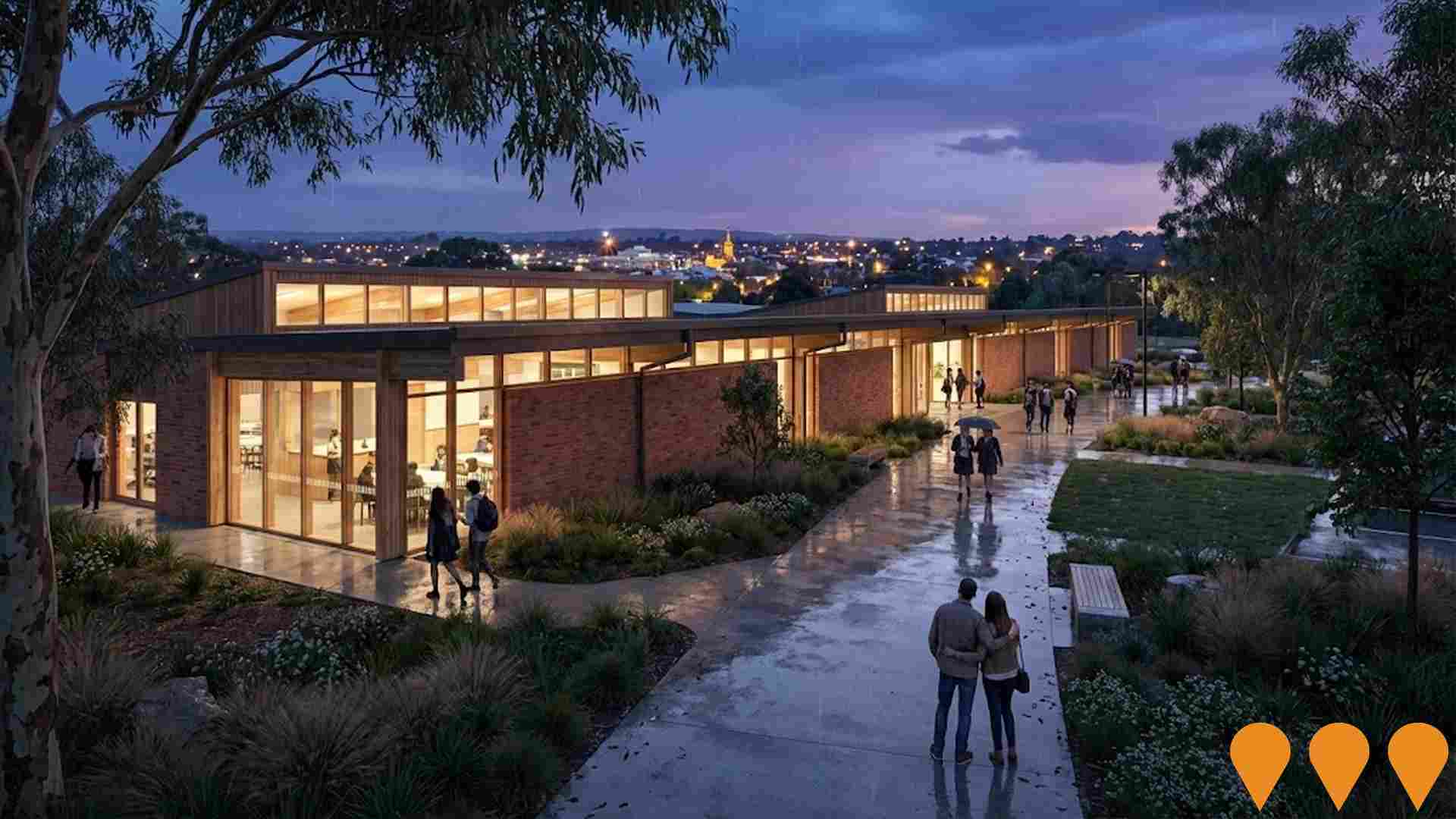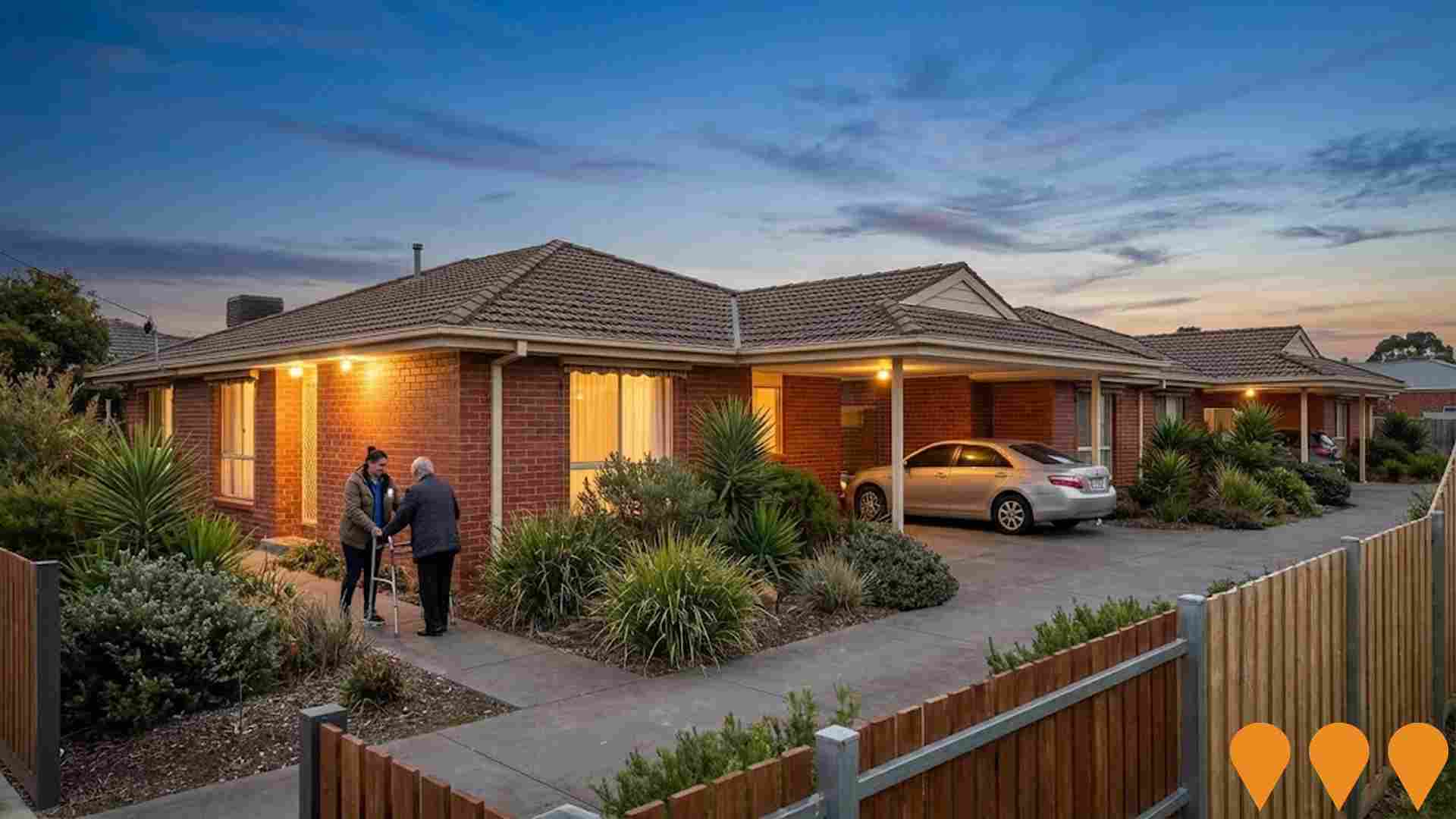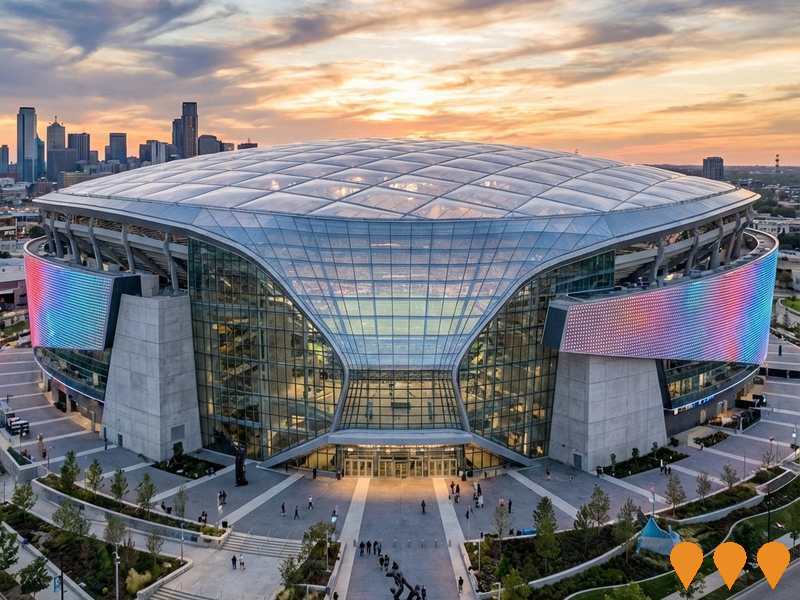Chart Color Schemes
est. as @ -- *
ABS ERP | -- people | --
2021 Census | -- people
Sales Activity
Curious about local property values? Filter the chart to assess the volume and appreciation (including resales) trends and regional comparisons, or scroll to the map below view this information at an individual property level.
Find a Recent Sale
Sales Detail
Population
Population growth drivers in Ballarat North - Invermay are strong compared to national averages based on AreaSearch's ranking of recent, and medium to long-term trends
Ballarat North - Invermay's population was around 15,425 as of August 2025. This showed an increase of 675 people since the 2021 Census, which recorded a population of 14,750. The growth was inferred from ABS estimates: 15,169 in June 2024 and additional validated addresses since the Census date. This resulted in a density ratio of 210 persons per square kilometer. Ballarat North - Invermay's 4.6% growth since census was close to the non-metro area's 5.5%, indicating strong growth fundamentals. Overseas migration contributed approximately 43.0% of overall population gains, with all drivers being positive factors.
AreaSearch uses ABS/Geoscience Australia projections for each SA2 area, released in 2024 with a base year of 2022. For areas not covered, it utilises VIC State Government's Regional/LGA projections from 2023, adjusted using weighted aggregation methods to SA2 levels. Growth rates by age group are applied across all areas for years 2032 to 2041. Based on these projections, Ballarat North - Invermay is forecast to increase by 4,436 persons by 2041, reflecting a total increase of 27.1% over the 17-year period.
Frequently Asked Questions - Population
Development
Residential development activity is slightly higher than average within Ballarat North - Invermay when compared nationally
Ballarat North - Invermay averaged approximately 68 new dwelling approvals annually over the past five financial years, from FY21 to FY25, totalling 343 homes. In FY26 up to June, 17 dwellings have been approved. On average, 1.6 people moved to the area each year for every dwelling built between FY21 and FY25, indicating balanced supply and demand with stable market conditions.
The average construction value of new properties was $545,000, moderately higher than regional levels, suggesting quality construction emphasis. This financial year has seen $2.9 million in commercial development approvals, reflecting the area's residential character. Compared to the Rest of Vic., Ballarat North - Invermay shows significantly reduced construction activity, with 62.0% fewer approvals per person, generally supporting stronger demand and values for established dwellings. Recent construction comprises 91.0% detached houses and 9.0% townhouses or apartments, preserving the area's low-density nature and attracting space-seeking buyers.
The estimated population per dwelling approval is 402 people, reflecting its quiet development environment. Future projections indicate Ballarat North - Invermay will add approximately 4,180 residents by 2041. At current development rates, housing supply may struggle to keep pace with population growth, potentially increasing buyer competition and supporting price increases.
Frequently Asked Questions - Development
Infrastructure
Ballarat North - Invermay has strong levels of nearby infrastructure activity, ranking in the top 40% nationally
The performance of a region is significantly influenced by changes in local infrastructure, major projects, and planning initiatives. AreaSearch has identified 36 such projects that may impact the area. Notable ones include La Trobe Street Saleyards Redevelopment, Central Neighbourhood Activity Centre Ballarat North, Ballarat North Precinct Structure Plan, and Ballarat Major Events Precinct Upgrades. The following list details those likely to be most relevant.
Professional plan users can use the search below to filter and access additional projects.
INFRASTRUCTURE SEARCH
 Denotes AI-based impression for illustrative purposes only, not to be taken as definitive under any circumstances. Please follow links and conduct other investigations from the project's source for actual imagery. Developers and project owners wishing us to use original imagery please Contact Us and we will do so.
Denotes AI-based impression for illustrative purposes only, not to be taken as definitive under any circumstances. Please follow links and conduct other investigations from the project's source for actual imagery. Developers and project owners wishing us to use original imagery please Contact Us and we will do so.
Frequently Asked Questions - Infrastructure
Ballarat Base Hospital Redevelopment
State funded redevelopment of Ballarat Base Hospital delivering a new seven level tower and main entrance on Sturt Street, a larger emergency department with an integrated mental health, alcohol and other drugs hub, a women and children hub, new critical care floor with theatres, procedure rooms, expanded ICU and endoscopy suites, a new helipad, around 100 extra inpatient and short stay beds, a new central energy plant and upgraded car parking to about 800 spaces. Early works, the central energy plant and the expanded car park are complete, and structural works on the main hospital tower in the third and final stage are now underway with overall completion targeted for late 2027.
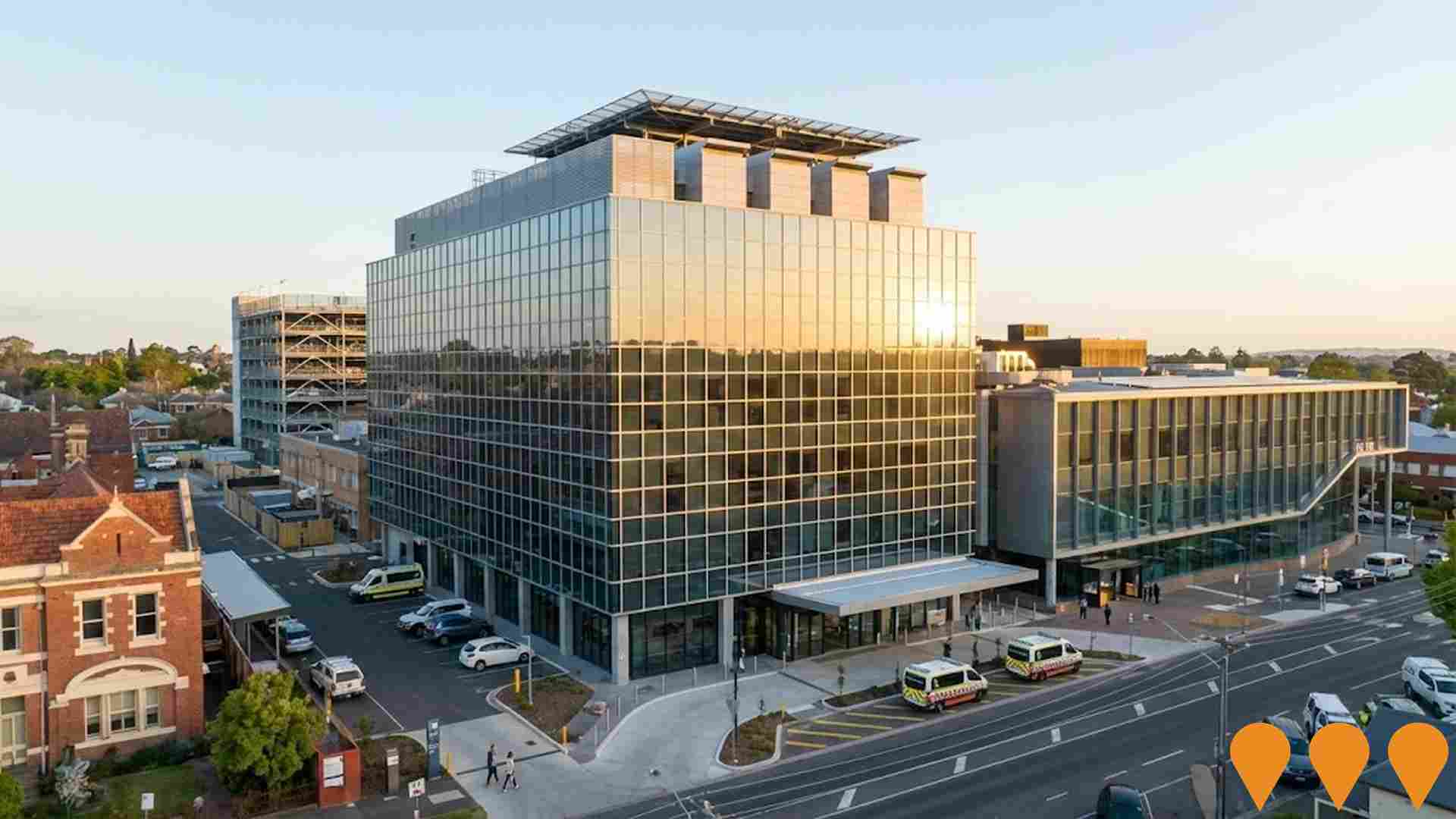
Ballarat North Precinct Structure Plan
The Ballarat North Precinct Structure Plan (PSP) is a long-term blueprint for urban development in Ballarat's Northern Growth Area, covering approximately 832 hectares (567-hectare core area rezoned to Urban Growth Zone and a 265-hectare expanded area under consideration). It will deliver around 5,600 new dwellings to accommodate approximately 15,000-15,480 residents. Key features include a neighbourhood activity centre, local convenience centre, two government primary schools, one government secondary school, community facilities, sporting reserves, local parks, road upgrades (including Gillies Road and Midland Highway), a new bridge over Burrumbeet Creek at Cummins Road, extensive walking/cycling paths, five new wetlands, and a minimum 13% affordable/social housing requirement. Draft documents were released for public consultation in September 2025, with submissions closing 20 October 2025; the VPA is currently reviewing submissions.
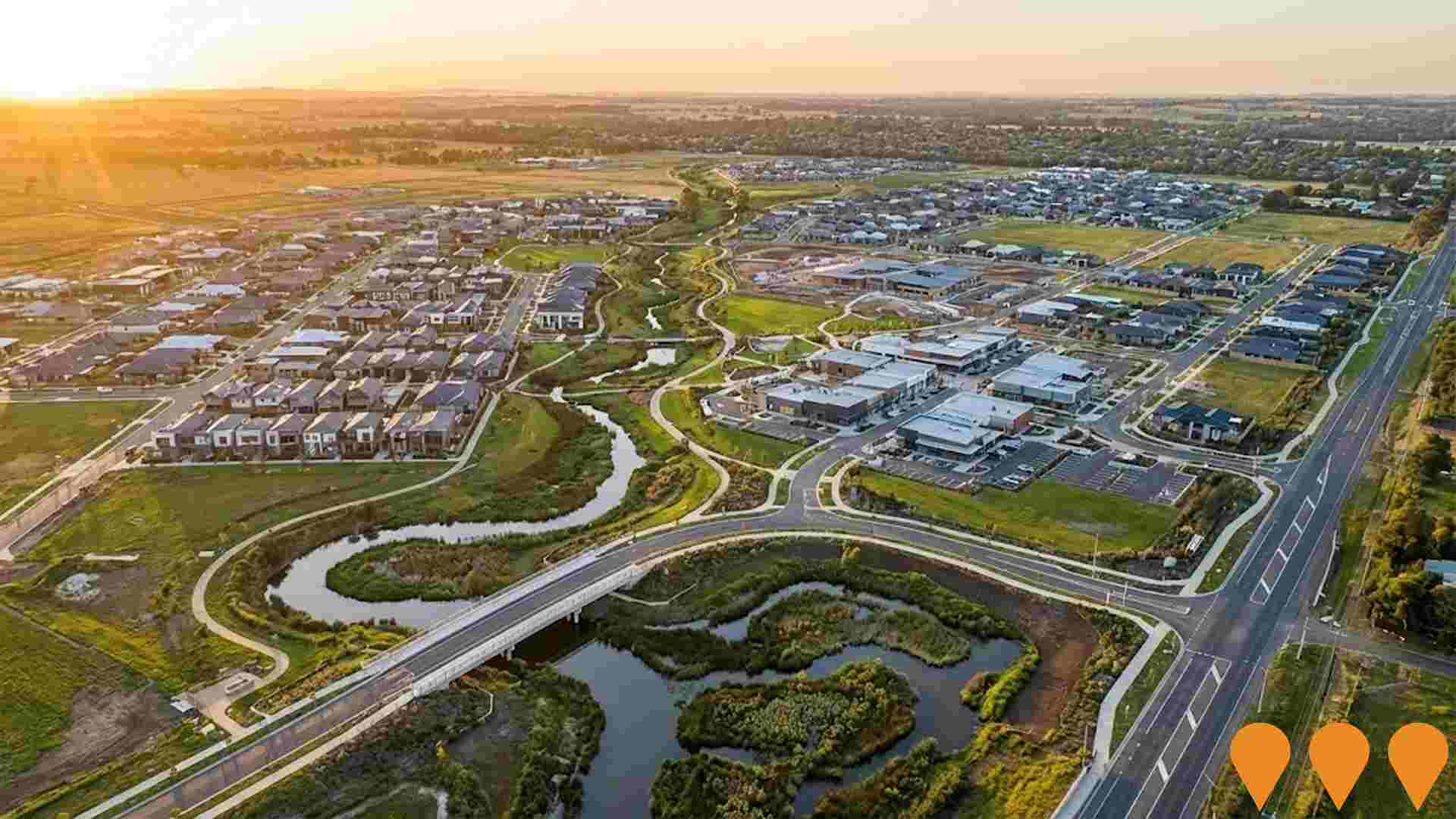
Central Neighbourhood Activity Centre Ballarat North
A planned large neighbourhood activity centre that is part of the Ballarat North Precinct Structure Plan (PSP), which will guide the development of approximately 5,600 new homes. The centre is planned to include retail and non-retail uses, with a total supermarket floorspace of 8,000-12,000 sqm at capacity, supporting two to three full-line supermarkets. The broader PSP includes provisions for a local convenience centre, community facilities, two government primary schools, a government secondary school, and two sporting reserves.
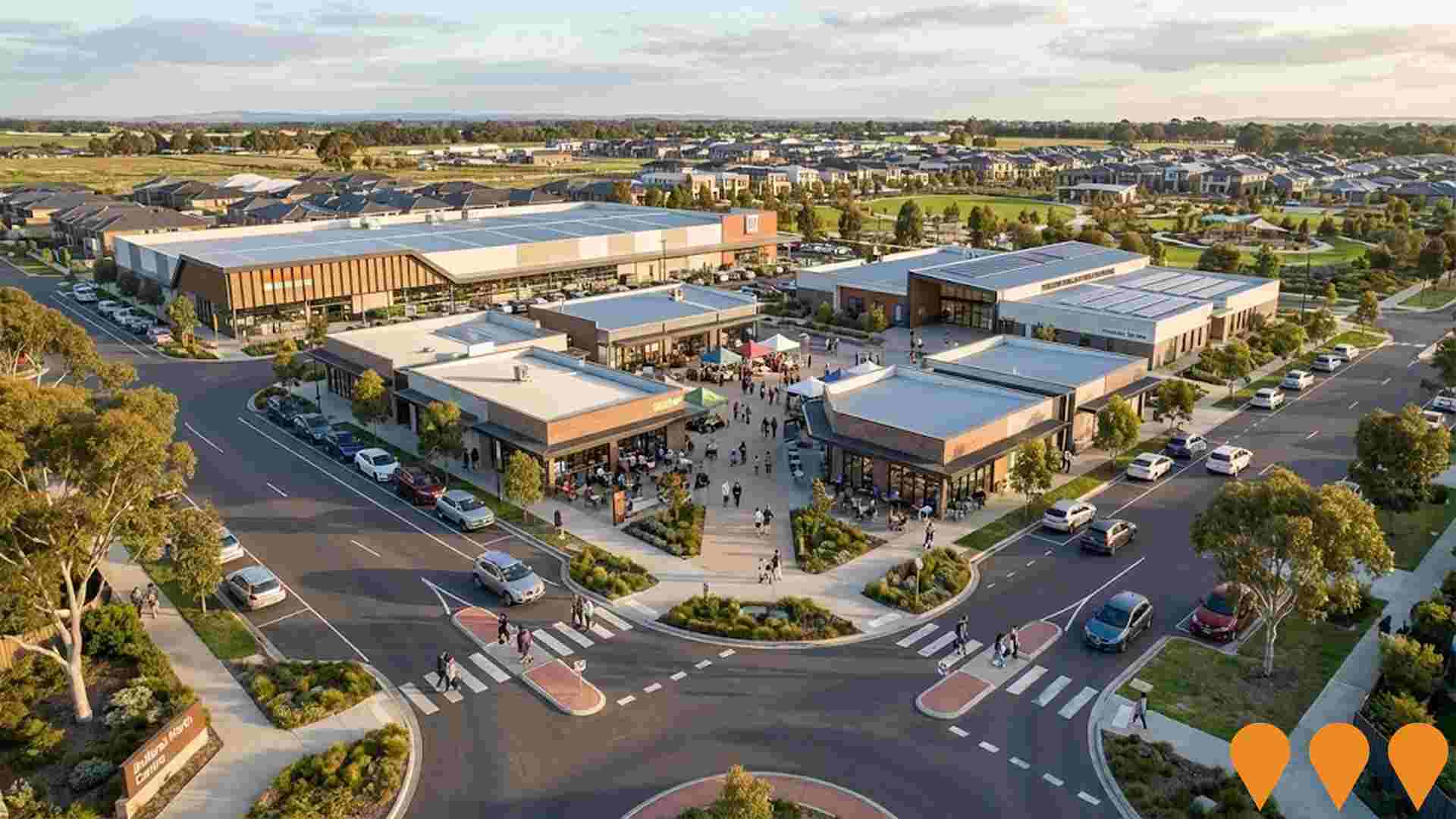
La Trobe Street Saleyards Redevelopment
Redevelopment of the historic former Ballarat Saleyards site (1864-2018) following soil remediation by Development Victoria. The project has potential to deliver a new employment precinct and future housing to support regional growth. Strategic planning led by City of Ballarat with heritage overlay protection for significant buildings including the 1909 Administration Building and Selling Pavilion.
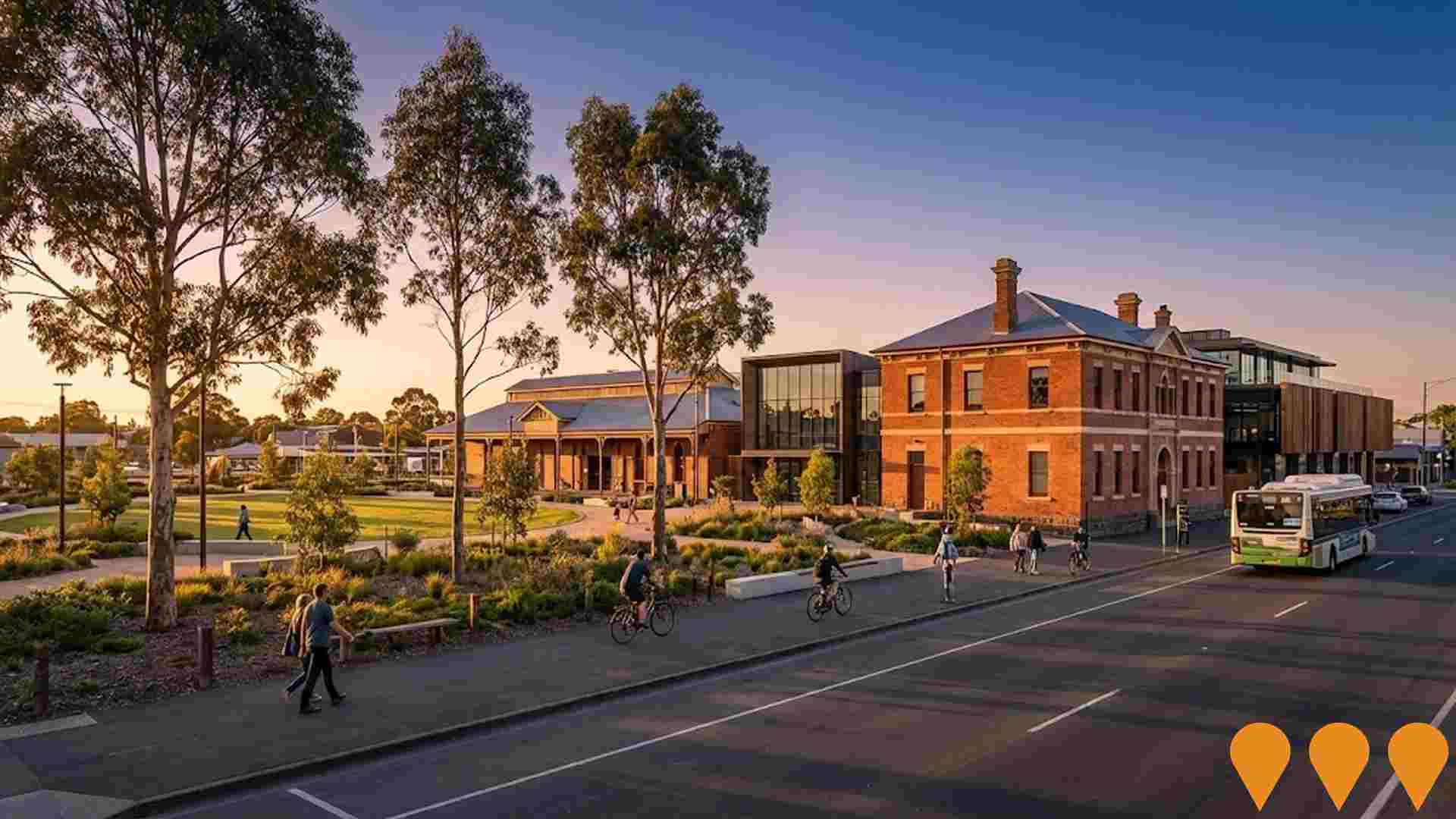
Ballarat Major Events Precinct Upgrades
The Ballarat Major Events Precinct Upgrades are delivering a major redevelopment of Mars Stadium and the surrounding Eureka Sports Precinct in Wendouree. The project includes 5,000 new permanent seats and upgraded amenities at Mars Stadium, a new Ballarat Regional Athletics Centre on the former showgrounds site with track, pavilion and lighting, plus improved accessibility, landscaping and public open space across the precinct. Led by Development Victoria as part of the Victorian Government Regional Sports Infrastructure Program, construction is underway and the works are expected to be completed in late 2026, strengthening Ballarat as a regional hub for elite sport and community events.
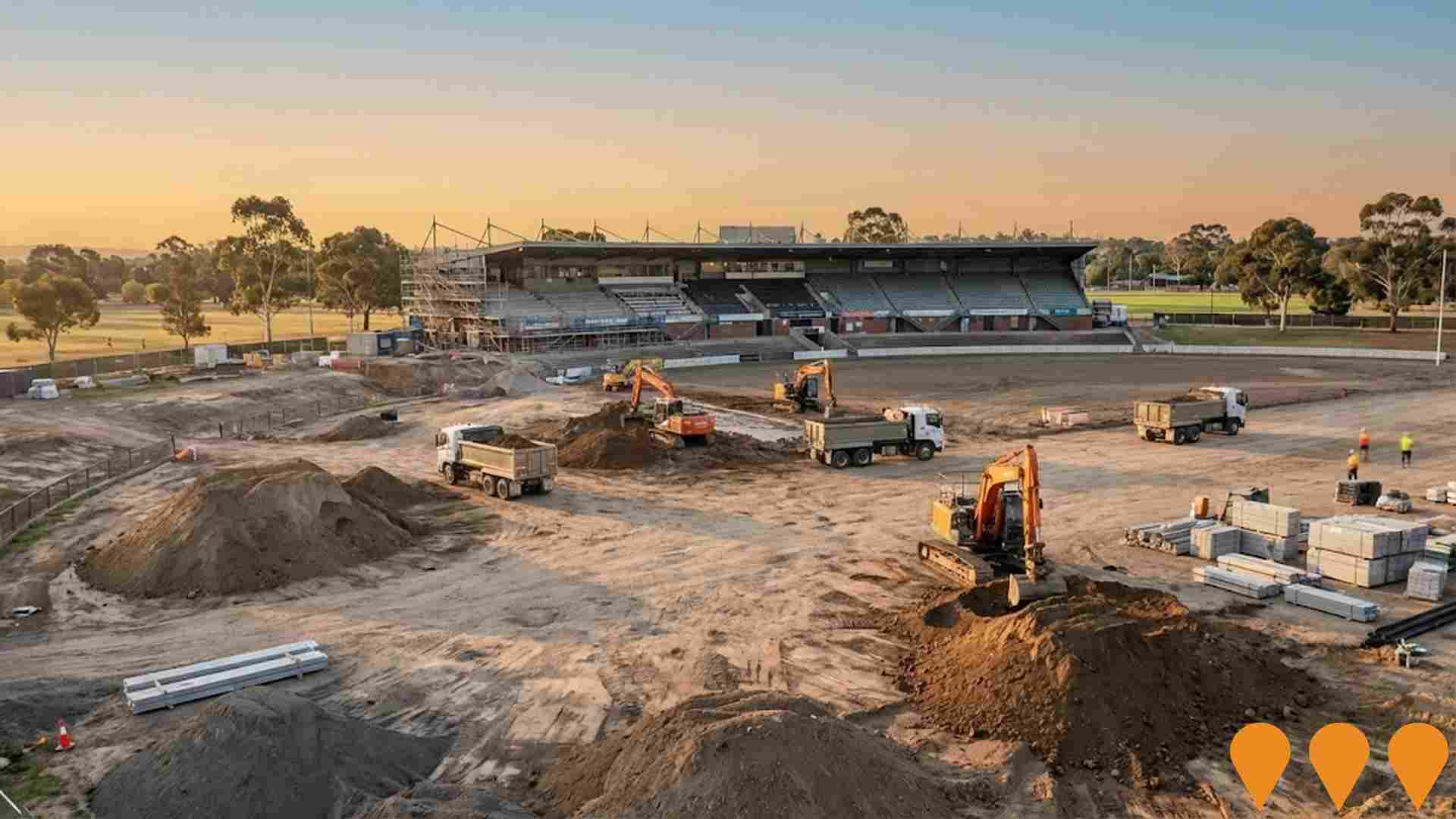
Federation University SMB Campus Redevelopment
Redevelopment of Federation University's historic SMB Campus in central Ballarat, featuring new state-of-the-art engineering and construction facilities, modern classrooms, computer labs, and upgraded student facilities. The project aims to modernize the campus while preserving its heritage character dating back to 1870.
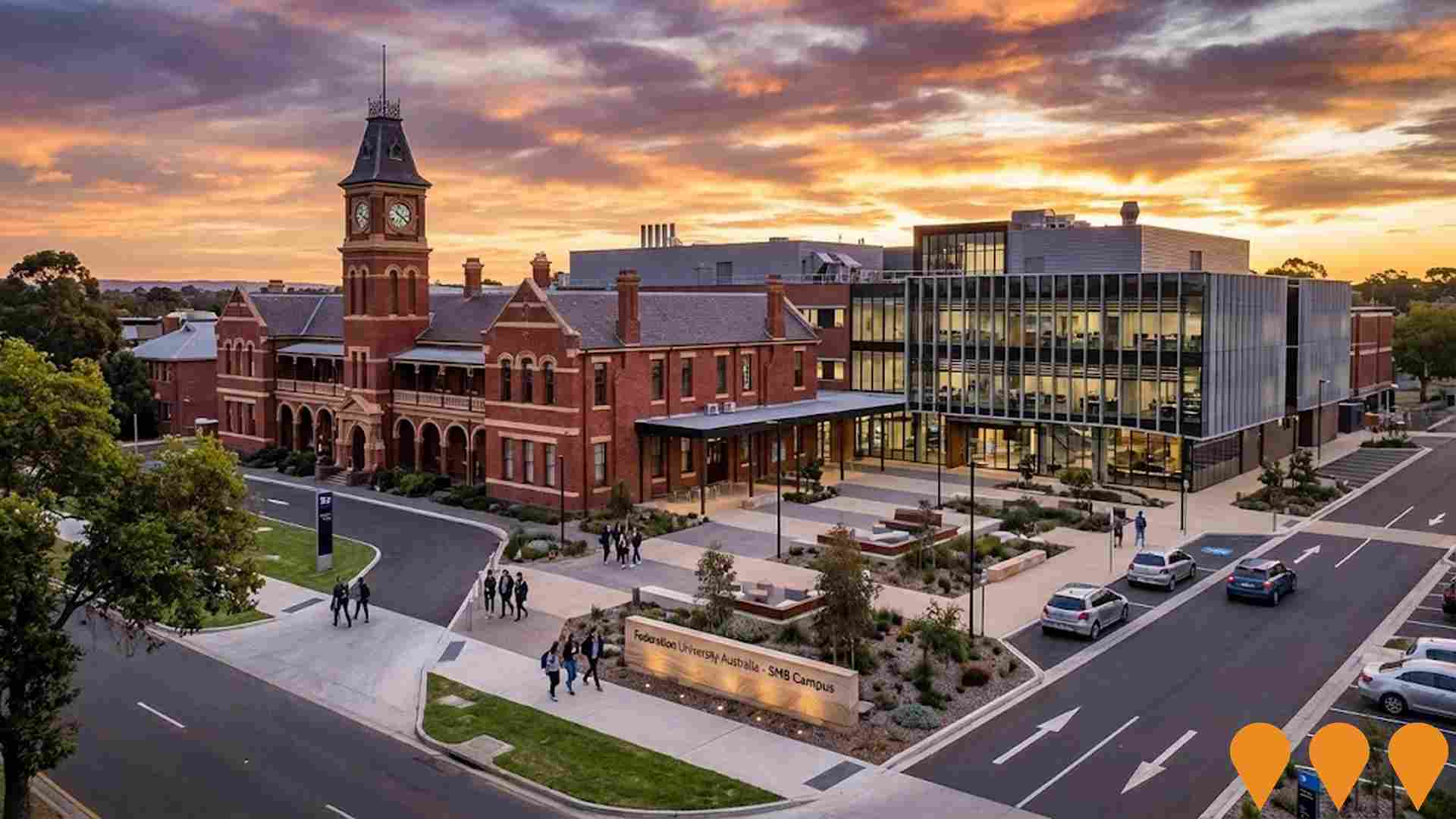
Bridge Mall Redevelopment
The Bridge Mall Redevelopment is a $23.3 million City of Ballarat project that has transformed the former pedestrian mall into a shared low speed street with limited parking, a landscaped Grenville Street entry, a new family friendly play space, smart lighting and a portal view to the Yarrowee River below. As a key project of the Bakery Hill Urban Renewal Plan, it is designed to restore Bridge Mall as a vibrant retail and civic destination, reduce vacancies and attract new private investment into the precinct.
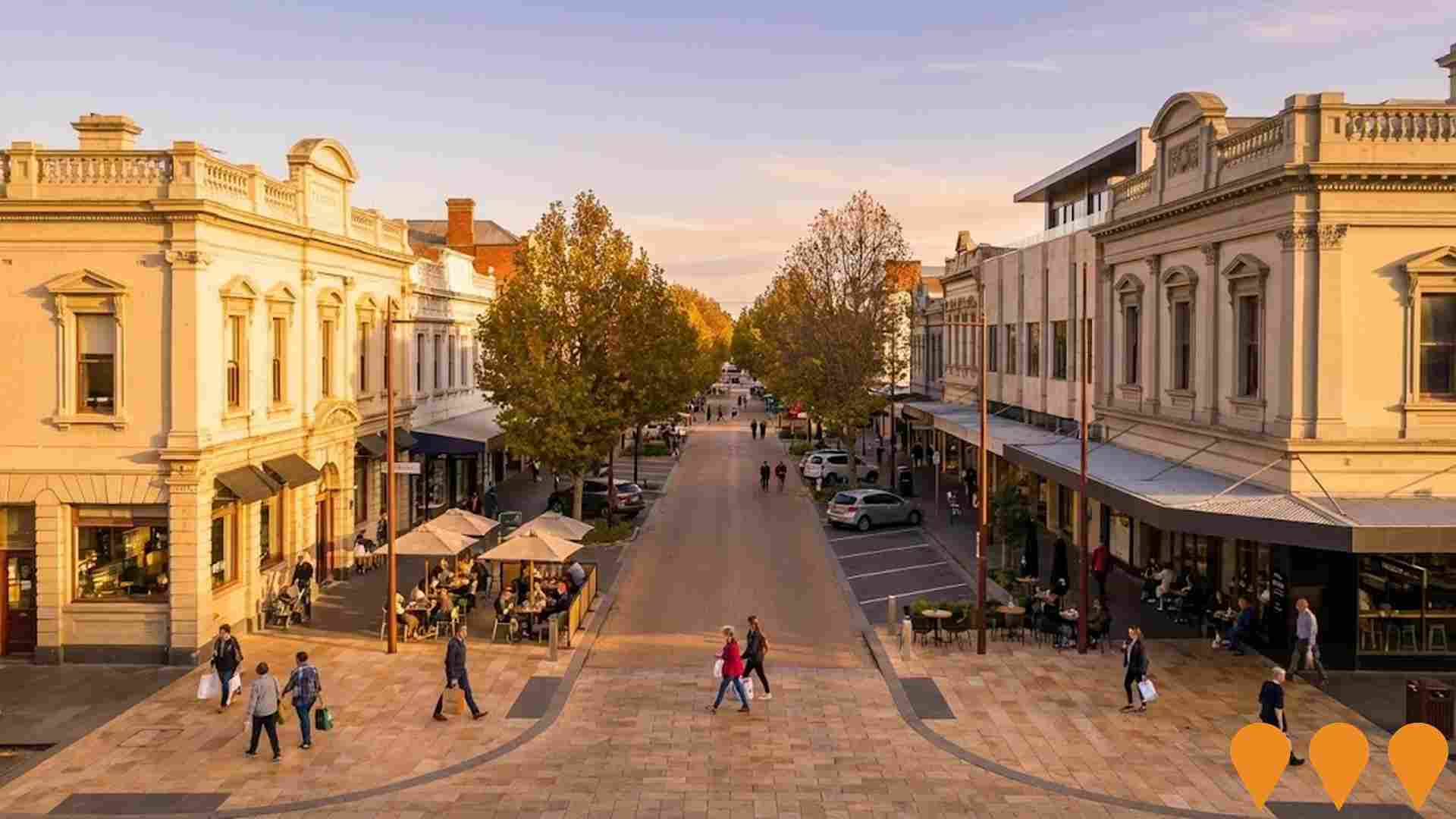
Eastwood Community Hub
A $17.54 million redevelopment of the Eastwood Leisure Complex in central Ballarat, replacing the 1940s-era facility with a contemporary, fully accessible multipurpose community hub. The new facility will feature a main hall accommodating 275 people that can be configured into three activity rooms, three training rooms, a dedicated community meeting room, a medium-sized conference and events space, fully accessible toilets including a Changing Places facility, and modern office and administration areas. The existing basketball stadium will be retained and reclad. The hub serves over 100 groups annually with 60,000 visits and 14,000 hours of programmed activity, supporting education, training, social services, physical activity, arts, culture, and community events.
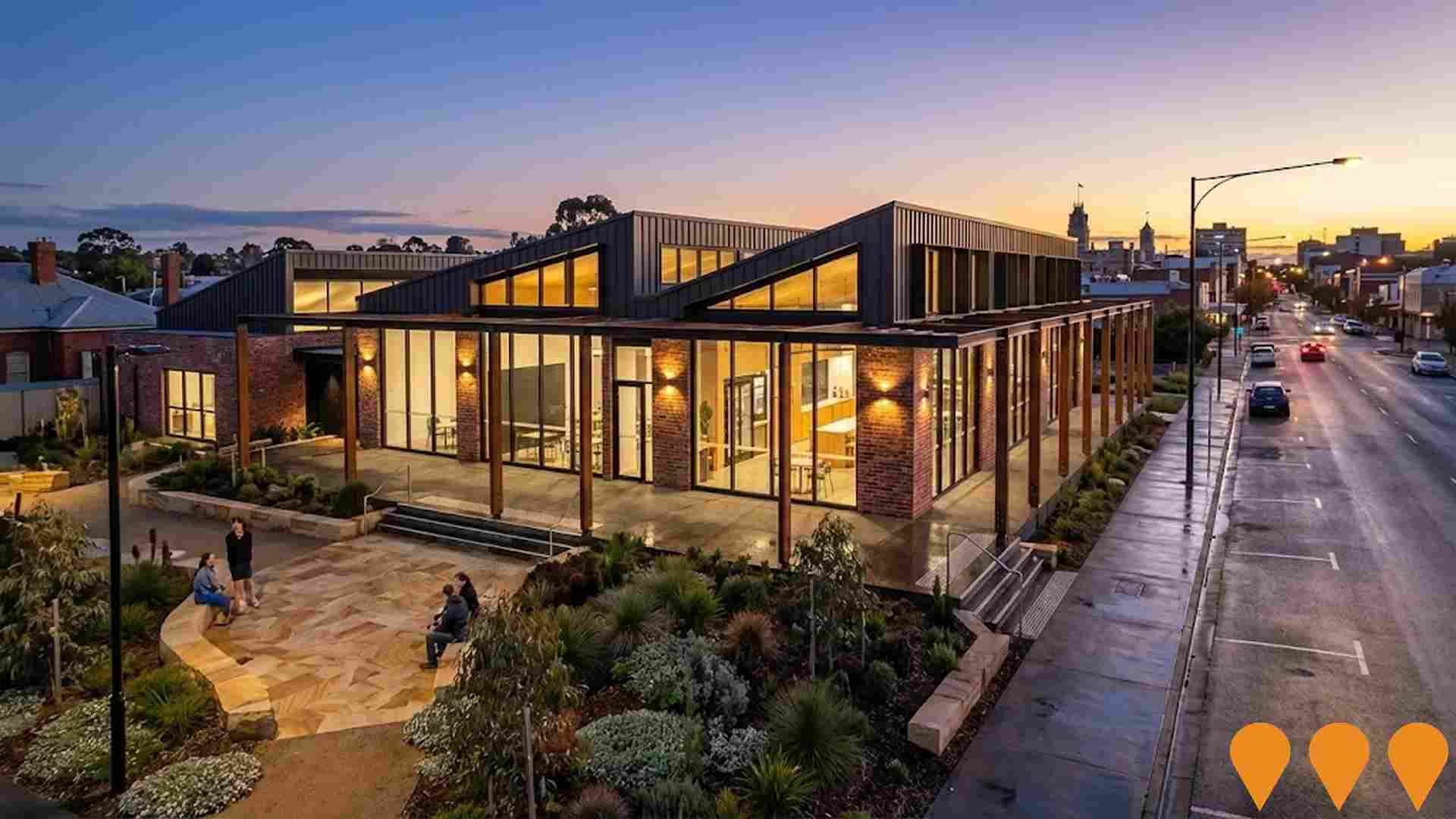
Employment
Ballarat North - Invermay ranks among the top 25% of areas assessed nationally for overall employment performance
Ballarat North - Invermay has a highly educated workforce with prominent representation in essential services sectors. The unemployment rate was 2.6% as of June 2025, with an estimated employment growth of 7.3% over the past year.
As of this date, 7,987 residents were employed while the unemployment rate was 1.2% lower than Rest of Vic.'s rate of 3.8%. Workforce participation in Ballarat North - Invermay was notably higher at 63.6%, compared to Rest of Vic.'s 57.4%. Key employment industries among residents included health care & social assistance, education & training, and construction. The area had a particular specialization in education & training, with an employment share 1.5 times the regional level.
Conversely, agriculture, forestry & fishing was under-represented, comprising only 1.3% of Ballarat North - Invermay's workforce compared to Rest of Vic.'s 7.5%. Employment opportunities locally appeared limited based on Census data comparison between working population and resident population. Between June 2024 and June 2025, employment levels increased by 7.3%, while labour force grew by 6.8%, leading to a decrease in unemployment by 0.4 percentage points. This contrasted with Rest of Vic., where employment contracted by 0.9%, labour force fell by 0.4%, and unemployment rose by 0.4 percentage points. Jobs and Skills Australia's national employment forecasts from May 2025 indicated potential future demand within Ballarat North - Invermay. These projections, spanning five and ten-year periods, suggested national employment growth of 6.6% and 13.7%, respectively. Applying these industry-specific projections to Ballarat North - Invermay's employment mix estimated local growth at approximately 6.7% over five years and 14.0% over ten years.
Frequently Asked Questions - Employment
Income
Income levels align closely with national averages, indicating typical economic conditions for Australian communities according to AreaSearch analysis
Ballarat North - Invermay had a median taxpayer income of $51,678 and an average income of $66,352 in financial year 2022. This was slightly above the national average, with Rest of Vic.'s median income being $48,741 and average income being $60,693. By September 2025, estimated incomes would be approximately $57,962 (median) and $74,420 (average), based on a 12.16% growth in wages since financial year 2022. Census 2021 income data showed that Ballarat North - Invermay's household, family, and personal incomes were around the 50th percentile nationally. Income analysis revealed that 31.2% of locals (4,812 people) fell into the $1,500 - 2,999 income category, similar to the surrounding region at 30.3%. Housing costs took up 12.8% of income, with disposable income being below average at the 48th percentile. The area's SEIFA income ranking placed it in the 6th decile.
Frequently Asked Questions - Income
Housing
Ballarat North - Invermay is characterized by a predominantly suburban housing profile, with above-average rates of outright home ownership
Ballarat North - Invermay had 88.3% houses and 11.6% other dwellings in its latest Census evaluation, compared to Non-Metro Vic.'s 85.6% houses and 14.5% other dwellings. Home ownership stood at 37.0%, with mortgaged dwellings at 36.7% and rented ones at 26.3%. The median monthly mortgage repayment was $1,560, above Non-Metro Vic.'s average of $1,499. Median weekly rent was $300, the same as Non-Metro Vic.'s figure. Nationally, Ballarat North - Invermay's mortgage repayments were lower at $1,560 compared to Australia's average of $1,863, and rents were substantially lower at $300 than the national figure of $375.
Frequently Asked Questions - Housing
Household Composition
Ballarat North - Invermay has a typical household mix, with a fairly typical median household size
Family households account for 67.2% of all households, including 29.5% couples with children, 27.7% couples without children, and 9.3% single parent families. Non-family households constitute the remaining 32.8%, with lone person households at 29.4% and group households comprising 3.2%. The median household size is 2.4 people, which aligns with the average for the Rest of Vic.
Frequently Asked Questions - Households
Local Schools & Education
Ballarat North - Invermay performs slightly above the national average for education, showing competitive qualification levels and steady academic outcomes
The area's university qualification rate is 31.2% among residents aged 15+, surpassing the Rest of Vic average of 21.7% and the SA4 region average of 24.6%. Bachelor degrees are most common at 19.9%, followed by postgraduate qualifications (6.7%) and graduate diplomas (4.6%). Vocational credentials are also prevalent, with 32.8% of residents aged 15+ holding such qualifications - advanced diplomas (11.1%) and certificates (21.7%). Educational participation is high at 28.1%, including 10.0% in primary education, 7.5% in secondary education, and 4.6% in tertiary education.
There are 8 schools operating within Ballarat North - Invermay, educating approximately 1,321 students, with typical Australian school conditions (ICSEA: 1014) and balanced educational opportunities. The educational mix includes 7 primary schools and 1 K-12 school. School capacity is limited at 8.6 places per 100 residents compared to the regional average of 18.0, leading many families to travel for schooling. Note: where schools show 'n/a' for enrolments, please refer to the parent campus.
Frequently Asked Questions - Education
Schools Detail
Nearby Services & Amenities
Transport
Transport servicing is good compared to other areas nationally based on assessment of service frequency, route connectivity and accessibility
Ballarat North - Invermay has 61 operational public transport stops. These include a combination of train and bus services. There are 52 unique routes serving these stops, which together facilitate 4,019 weekly passenger trips.
The area's transport accessibility is deemed good, with residents situated an average of 299 meters from the nearest stop. Across all routes, there are approximately 574 daily trips and each stop receives about 65 weekly trips.
Frequently Asked Questions - Transport
Transport Stops Detail
Health
Health performance in Ballarat North - Invermay is lower than average with common health conditions somewhat prevalent across both younger and older age cohorts
Ballarat North - Invermay has significant health challenges, with common health conditions prevalent across both younger and older age cohorts.
The area has a private health cover rate of approximately 52%, which is higher than the average SA2 area. Mental health issues and asthma are the most common medical conditions, affecting 10.1% and 9.2% of residents respectively. Sixty-four point four percent of residents declared themselves completely clear of medical ailments, compared to 62.3% across Rest of Vic.. Nineteen point three percent of residents are aged 65 and over (2,975 people), which is higher than the 17.8% in Rest of Vic.. Health outcomes among seniors present some challenges, broadly in line with the general population's health profile.
Frequently Asked Questions - Health
Cultural Diversity
Ballarat North - Invermay is considerably less culturally diverse than average when assessed alongside AreaSearch's national rankings for language and cultural background related metrics
Ballarat North - Invermay showed lower cultural diversity with 90.4% of its population born in Australia, 92.9% being citizens, and 95.1% speaking English only at home. Christianity was the predominant religion, accounting for 49.7%. This figure is higher than the regional average of 45.0% across Rest of Vic..
The top three ancestry groups were English (31.5%), Australian (27.0%), and Irish (13.0%). Notably, Scottish ancestry was overrepresented at 10.0%, compared to 9.2% regionally. Dutch and Maltese ancestries also showed slight divergences with 2.0% and 0.5% respectively, versus regional averages of 2.1% and 0.4%.
Frequently Asked Questions - Diversity
Age
Ballarat North - Invermay's median age exceeds the national pattern
The median age in Ballarat North - Invermay is 40 years, which is slightly below the Rest of Vic.'s average of 43 but above Australia's median of 38. Compared to the Rest of Vic., the 25-34 cohort is notably higher at 13.2% locally while the 65-74 age group is lower at 10.8%. Between the 2021 Census and now, the 35-44 age group has increased from 13.0% to 14.0%, while the 55-64 cohort has declined from 13.1% to 11.6%. By 2041, population forecasts indicate significant growth in the 25-34 age group, projected to expand by 1,408 people (69%) from 2,042 to 3,451. The 55-64 group is expected to grow modestly at 5%, adding only 82 residents.
